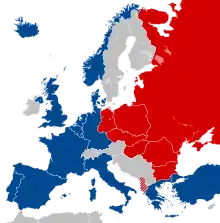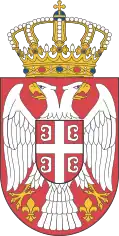Democratic Federal Yugoslavia, also known as Democratic Federative Yugoslavia (DF Yugoslavia or DFY), was a provisional state established during World War II on 29 November 1943 through the Second Session of the Anti-Fascist Council for the National Liberation of Yugoslavia (AVNOJ). The National Committee for the Liberation of Yugoslavia (NKOJ) was its original executive body. Throughout its existence it was governed by Marshal Josip Broz Tito as prime minister.
It was recognized by the Allies at the Tehran Conference, along with the AVNOJ as its deliberative body. The Yugoslav government-in-exile of King Peter II in London, partly due to pressure from the United Kingdom,[3] recognized the AVNOJ government with the Treaty of Vis, signed on 16 June 1944 between the prime minister of the government-in-exile, Ivan Šubašić, and Tito.[3] With the Treaty of Vis, the government-in-exile and the NKOJ agreed to merge into a provisional government as soon as possible. The form of the new government was agreed upon in a second Tito–Šubašić agreement signed on 1 November 1944 in the recently liberated Yugoslav capital of Belgrade. DF Yugoslavia became one of the founding members of the United Nations upon the signing of the United Nations Charter in October 1945.
The state was formed to unite the Yugoslav resistance movement to the occupation of Yugoslavia by the Axis powers. The agreement left the issue of whether the state would be a monarchy or a republic intentionally undecided until after the war had ended so the position of head of state was vacant. After the merger of the governments, the state was reformed as a one-party Federal People's Republic of Yugoslavia with Josip Broz Tito as Prime Minister and Ivan Šubašić as minister of foreign affairs.
History
The Second Session of the AVNOJ, held in Jajce in November 1943, opened with a declaration that read in part:
- That the Anti-Fascist Council of National Liberation of Yugoslavia be constituted as the supreme legislative and executive representative body of Yugoslavia as the supreme representative of the sovereignty of the peoples and of the State of Yugoslavia as a whole, and that a National Committee of Liberation of Yugoslavia be established as an organ with all of the features of a national government, through which the Anti-Fascist Council of National Liberation of Yugoslavia will realize its executive function.
- That the traitorous "government" in exile be deprived of all rights as the legal government of Yugoslavia, particularly of the right to represent the peoples of Yugoslavia anywhere or before anyone.
- That all international treaties and obligations concluded abroad in the name of Yugoslavia by the "government" in exile be reviewed with a view to their invalidation or renewal or approval, and that all international treaties and obligations which the so-called "government" in exile may eventually conclude abroad in the future receive no recognition.
- That Yugoslavia be established on a democratic federal principle as a state of equal peoples.[4]
The AVNOJ then issued six decrees and the Presidium of the AVNOJ, which continued its functions when it was not in session, followed with four decisions. Together these comprised the constitution of the new state taking shape in Yugoslavia. On 30 November the Presidium gave Tito the rank of Marshal of Yugoslavia and appointed him president of the government (or acting prime minister) and Minister of National Defence. Three vice presidents and thirteen other ministers were appointed to the NKOJ.[4]
The name "Democratic Federative Yugoslavia" was officially adopted on 17 February 1944. On the same day they adopted the five-torch emblem of Yugoslavia.[5]
After the deposition of King Peter II, the Federal People's Republic of Yugoslavia was proclaimed on 29 November 1945.
Government
Its legislature, after November 1944, was the Provisional Assembly.[6] The Tito-Šubašić agreement of 1944 declared that the state was a pluralist democracy that guaranteed: democratic liberties; personal freedom; freedom of speech, assembly, and religion; and a free press.[7] However, by January 1945 Tito had shifted the emphasis of his government away from emphasis on pluralist democracy, claiming that though he accepted democracy, he claimed there was no "need" for multiple parties, as he claimed that multiple parties were unnecessarily divisive in the midst of Yugoslavia's war effort and that the People's Front represented all the Yugoslav people.[7] The People's Front coalition, headed by the Communist Party of Yugoslavia and its general secretary Marshal Josip Broz Tito, was a major movement within the government. Other political movements that joined the government included the "Napred" movement represented by Milivoje Marković.[6]
Democratic Federal Yugoslavia was ruled by Temporary Government consisting mostly of Unitary National Liberation Front members and small number of other political parties from former Kingdom of Yugoslavia. President of the Government was Josip Broz Tito. Communists held 22 minister positions, including Finances, Internal Affairs, Justice, Transport and others. Ivan Šubašić, from Croatian Peasant Party and former ban of Croatian Banovina, was minister of Foreign Affairs, while Milan Grol, from Democratic Party, was Deputy Prime Minister. Many non-communist government members resigned due to disagreement with the new policy.[8]
Administrative divisions
Democratic Federal Yugoslavia consisted of 6 federal states and 2 autonomous units:[9][10]
- Federated State of Serbia
- Federated State of Croatia
- Federated State of Bosnia and Herzegovina
- Federated State of Slovenia
- Federated State of Montenegro
- Federated State of Macedonia

References
- ↑ These were the languages specified for the Emblem of Yugoslavia on 17 February 1944.
- ↑ Tomasz Kamusella. The Politics of Language and Nationalism in Modern Central Europe. Palgrave Macmillan, 2008. Pp. 228, 297.
- 1 2 Walter R. Roberts. Tito, Mihailović, and the allies, 1941-1945. Duke University Press, 1987. Pp. 288.
- 1 2 Michael Boro Petrovich, "The Central Government of Yugoslavia", Political Science Quarterly, Vol. 62, No. 4 (1947), pp. 504–30.
- ↑ Marko Attila Hoare, The Bosnian Muslims in the Second World War: A History (Oxford University Press, 2013), p. 200.
- 1 2 Vojislav Koštunica, Kosta Čavoški. Party pluralism or monism: social movements and the political system in Yugoslavia, 1944-1949. East European Monographs, 1985. Pp. 22.
- 1 2 Sabrina P. Ramet. The three Yugoslavias: state-building and legitimation, 1918-2005. Bloomington, Indiana, USA: Indiana University Press. Pp. 167-168.
- ↑ http://adattar.vmmi.org/fejezetek/2078/09_prva_decenija_titove_jugoslavije.pdf
- ↑ Petranović 2002.
- ↑ Jović 2009.
Sources
- Bokovoy, Melissa K.; Irvine, Jill A.; Lilly, Carol S., eds. (1997). State-Society Relations in Yugoslavia, 1945-1992. London: Palgrave Macmillan. ISBN 9780312126902.
- Dimić, Ljubodrag (2011). "Yugoslav-Soviet Relations: The View of the Western Diplomats (1944-1946)". The Balkans in the Cold War: Balkan Federations, Cominform, Yugoslav-Soviet Conflict. Beograd: Institute for Balkan Studies. pp. 109–140. ISBN 9788671790734.
- Jović, Dejan (2009). Yugoslavia: A State that Withered Away. West Lafayette: Purdue University Press. ISBN 9781557534958.
- Pavlowitch, Stevan K. (2002). Serbia: The History behind the Name. London: Hurst & Company. ISBN 9781850654773.
- Petranović, Branko (2002). The Yugoslav Experience of Serbian National Integration. Boulder: East European Monographs. ISBN 9780880334846.
.svg.png.webp)




